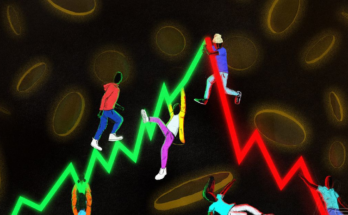
Cryptocurrency has entered the culture wars, and everyone’s picking sides. Administrators at Creative Commons recently discovered that many of their supporters can’t fucking stand NFTs. The squabble raises questions about the future of ownership, sharing, and the philosophical outlook of techno-utopians everywhere.
Creative Commons, the nonprofit that issues creative commons licenses, is a torchbearer of internet sharing culture. Its purpose is to promote a version of copyright that allows anyone to use and distribute images, while artists can pick and choose from a menu of exclusive rights. Some licenses allow people to commercialize and manipulate the work, some only let third parties share the image as-is, and all stipulate that artists get credit. Thanks to this, we have Wikimedia Commons and lots of legitimate ways to make memes.
Blockchain and Web3 skeptics consider NFTs to be Dutch tulip bulbs for speculators who use art as a front for appreciating value, passing the bag along to the next schmuck. This is why commenters on Creative Commons’s Twitter timeline did not appreciate this tweet: “Here’s a look at how museums are starting to use NFTs to educate the public, create new revenue streams, and engage their audiences.” The organization then linked to a fairly benign round-up of museum panel discussions about NFTs on cuseum.com.
Blockchain critic David Gerard accused Creative Commons of “shilling” for the NFT cause because, in his opinion, “approximately 100% of people who say NFTs are any good anywhere are shilling.” Commenters called the tweet “shameful,” “embarrassing,” and “disgusting.” To the point: “how the fuck is this compatible with the mission of creative commons”?
At a glance, NFTs could, sort of, align with Creative Commons’s mission because they are capable of separating sharing from ownership. An NFT is a certificate of ownership on the blockchain, typically including a link to an associated image or file in the metadata. Unless the artist hands over copyright to the buyer in a sales agreement, the artist retains copyright. This is customary in real life, enabling artists to distribute postcards or prints of a painting. But on the internet, this means that the artist can continue sharing visual or audio data that is identical to the NFT’d file with everyone. To right-clickers’ delight, buyers spend thousands or even millions of dollars on contracts attached to the file linked in the NFT.
That outcome sounds like something of a fit for Creative Commons. Around the big web revolution of the early 2000s, founder Lawrence Lessig correctly anticipated that remix culture called for new forms of copyright. We expect Creative Commons to figure out how to preserve the commons during the next big shift.
Over the phone, Lessig (who’s now a board member at CC) compared an NFT to the potential opportunity to buy and keep a statue, while sharing a photo of the statue using a CC BY license. “That’s basically the only idea, I think, anybody’s been talking about,” he said. (Lessig, like Creative Commons CEO Catherine Stihler, clarified several times that no one should promote NFTs unless they could be guaranteed carbon-free.)
But the market driving NFTs undermines hope of a freer, share-happy internet. People obtain creative commons licenses because they are true believers in sharing. People mint and buy NFTs because they would like to make money. Collectors possess all the leverage to control sales conditions, including copyright provisions, because their money is in higher demand than art.
Eventually, collectors may decide that they want to buy from the guy who’ll also transfer them some IP. That’s exactly what Bored Ape Yacht Club—a group that sells NFT’d cartoons of bored apes which double as membership tokens—has done. It grants copyright licenses to ape-holders, who can freely swag their ape. Some have suggested that this might be why apes’ prices are rising while the more copyright-restrictive CryptoPunks are hitting a slump.
Or collectors could go in a different direction and decide to grant artists the right of first refusal, a right which artists often like to retain in order to keep an eye on their work’s price fluctuations in the market. But that’s not a guarantee or a model, just a handout. Artists have been taking those as long as patronage has existed.
“If NFTs represented anything new with respect to copyright, I think the insight of Creative Commons would be very welcome,” Kyle McDonald, an artist who has dedicated research to studying ethereum-mining’s energy waste, told Gizmodo via DM. “But I don’t think NFTs really introduce anything new with respect to copyright, so it is unfortunate for Creative Commons to be engaging with the topic uncritically given the potential harms of NFTs.”
This is why it’s almost impossible to take a neutral stance on NFTs: They’re powering a libertarian wealth class that is aware most of what’s ownable on Earth is already owned. These people want to be early to buying up a whole new virtual planet (tHe MeTavErsE) while fucking the one we currently have.
“I follow the NFT and web3 scene pretty closely, and a lot of them have sort of new leftist ideals,” McDonald said. “They want to create networks of care and support. I don’t know if they can see that these systems were designed for a very different purpose.” He pointed to early conversations amongst libertarian cypherpunks, like the “Cyphernomicon,” a 1994 document written by deceased crypto-anarchy movement founder Tim May:
Crypto anarchy means prosperity for those who can grab it, those competent enough to have something of value to offer for sale; the clueless 95% will suffer, but that is only just. With crypto anarchy we can painlessly, without initiation of aggression, dispose of the nonproductive, the halt and the lame.
Now would be a great time to be Tim May. The blockchain is extremely useful to people who are “competent enough” to dupe people into buying things they don’t understand. That’s its defining use case. If the metaverse actually gets built (unlikely near-term), tokens would be the only representation of ownership.
They are also uniquely useful to process nonsense transactions that a bank might deem prohibitively high-risk. Transactions like the purchase of metaverse real estate contracts, dimly imagined as an open-world Minecraft-y hellscape that landlords are literally equating with buying the digital version of “5th Avenue back in the 1800s.” (The Sandbox metaverse has 166,464 plots of land that, at today’s average price of 3.6ETH, are worth a total of $2.3 billion.)
On its face, this is absurd. It’s like buying up real estate contracts with the Lunar Registry, trusting that the Moon will soon be a popular destination to live and travel. Yes, some guy on Earth is allowed to sell contracts claiming ownership of land on the Moon, but there’s no reason to believe those contracts would be legally binding in the event that a bunch of people start moving to the Moon.
Still, the proprietor of Lunar Registry is an early mover in an industry with little competition, so it’s at least a little bit possible that the rubes who bought land on the Moon in 2021 could have a legitimate claim someday.
Okay, now who gets to be the metaverse’s landlord? These guys are quite literally buying up metaverse stadiums and towers—exactly the dystopian privatized internet Creative Commons was supposed to guard against. It’s in Mark Zuckerberg’s best interest to grow a huge economy for non-essential digital crap that costs nothing to produce. Likewise for billionaire Jensen Huang, CEO of GPU company Nvidia, who’s predicting that the metaverse economy will be larger than the one for tactile objects. Investor pack leader Cathy Wood’s predicting a multitrillion-dollar market. The person who’s selling Justin Bieber tickets at the NFT’d digital stadium probably doesn’t want a bunch of non-NFT’d copycats popping up around the neighborhood.
So, yeah, everyone’s claiming to own the Moon. This is why Vili Lehdonvirta, professor of economic sociology and digital social research at the Oxford Internet Institute, scolded me for “engaging in speculation that provides cover for grift.”
“There was once a property boom in Second Life, too,” he wrote. “How did that end?”



